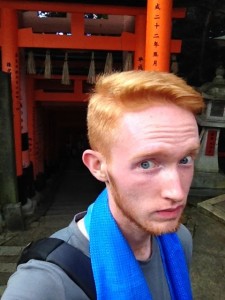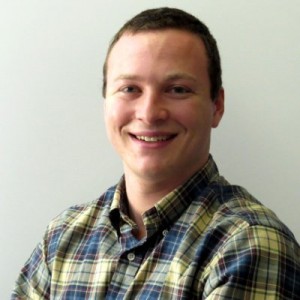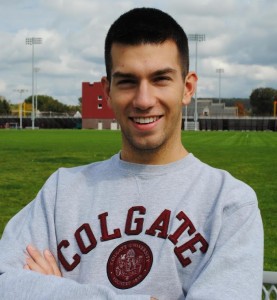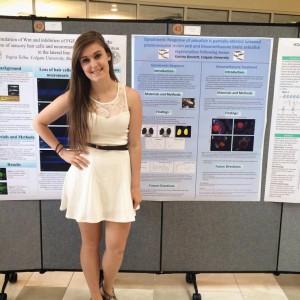 Week 1 Prompt: Coffee
Week 1 Prompt: Coffee
Few commodities are as ubiquitous and varied as coffee. Frappuccinos, cappuccinos, espresso, Turkish coffee, chocolate-covered coffee beans, iced coffee, dehydrated “instant” coffee, a French press, and American-style “drip” coffee: coffee, in one form or another, can be found in almost every part of the world — sometimes with hints of local flavor, or after-tastes of European colonialism. This week, observe how, where, and when people consume coffee. Is it a morning or afternoon beverage? Is it consumed “black” or with copious sugar? What is the most common form of coffee you see? (E.g. Iced, cappuccino, latte, K-cup, etc.) Do people prefer drinking from porcelain, or are take-away cups prevalent? Is coffee considered a luxury or is it essential to daily life? Are there local customs and history that inform how and why people drink coffee? Take at least one picture of a local coffee shop, your morning cup, or a coffee menu at a cafe. Avoid visiting Starbucks, if you can!
Ryan Hildebrandt ’17, Psychology & Japanese
Coffee in Japan is, like many aspects of the island nation, a bit of a dichotomy. Every day on my commute to school, through residential streets and city blocks, there were vending machines everywhere. Actually everywhere. It was a rare day indeed when I didn’t pass at least ten or twenty going about my daily routine, with every one I saw was advertising drinks of all kinds for sale with vibrant colors and celebrity endorsements. That’s where Tommy Lee Jones and his apparent thirst for the Boss Gold Label coffee drink comes in. It wasn’t uncommon to see his face on many of the vending machines selling coffee or coffee based beverages. Strange endorsements are a common sight on the streets of Kyoto, and this is representative of one end of the coffee spectrum available in Japan: the commercialized end.

Tommy Lee Jones on a “Boss” coffee machine in Kyoto.
On the opposite end of the coffee experience scale is the pure, hand processed, rich coffee of the Bonin Islands, one of the few places in Japan where Coffee can grow. I had the experience, along with my fellow students, to pick coffee fruit off the bush (called cherries before they’re processed into the more familiar beans) and taste the flesh of the coffee cherries. They were sweet and somewhat juicy, but the inner coffee bean was bitter and quite unpleasant if you made the mistake of biting into it. After picking the cherries and taking them through the bean separating process, we were treated to a cup of black Ogasawara (the name of the village in which the coffee farm was located) Coffee. I’ll admit, I’m not much of a coffee drinker, and in all honesty the first time I had tried coffee was about a month earlier in a small Japanese department store. But something about this coffee, perhaps the smell, perhaps the richness, perhaps the fact that I knew how it was made and how much effort went into each cup, told me that it was something special, something which was as far from the canned coffee on street corners as we were from the nearest Starbucks (about 600 miles away, imagine that).
Adam Basciano ’16, International Relations
Shalom from the Holy Land! Coffee is indeed an important part of Israeli culture. It comes in many different forms and is enjoyed by many. Tourists from America and other countries rush to kiosks and coffee shops for the delicious iced cafes. Here, an ice cafe is not simply coffee with ice, but rather a delicious and refreshing blended beverage. For native Israelis, also known as “Sabras”, a typical cup of coffee is whipped up quickly using Nescafe, an instant coffee brand. For late afternoon and evening relaxing, it is common for Israelis to enjoy Turkish black coffee. I am not sure where this tradition stems from, but it is hard to find an Israeli of any descent who does not own tiny shot-glass sized cups and the other essentials for making this delicious, awakening drink.
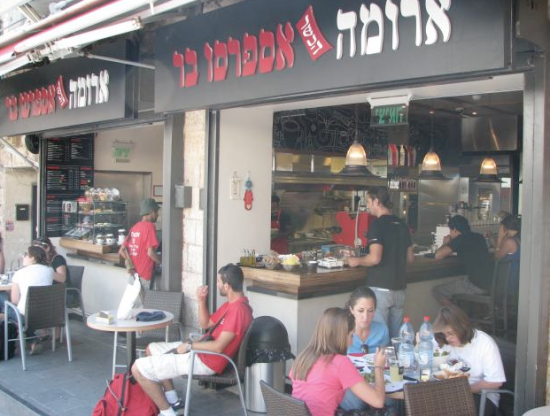
“Aroma” coffee storefront in Israel.
While it is easy to avoid visiting Starbucks while here in Israel, it is nearly impossible to skip out on the “Starbucks of Israel”, a description of the vastly popular “Aroma” (seen bove). Aroma is enjoyed by all, tourists and Sabras alike, as it is the first widely popular coffee chain in Israel.
Kevin Costello ’16, Philosophy & Political Science
When you think of large American cities that double as college towns, Boston is probably what comes to mind. I’d always known that Washington had its fair share of higher learning, but it wasn’t until Tryst that I fully grasped that DC has such a large, vibrant academic community of its own. Tryst, a coffee-shop-and-then-some located in DC’s colorful Adams Morgan neighborhood, enjoys a surprisingly strong draw from seemingly all of Washington’s geographically dispersed colleges and universities. When I first arrived on Sunday afternoon to do some homework, I expected a fairly calm environment, with perhaps a few American University students recharging and preparing for the upcoming week.

Tryst Coffeehouse in the Adams Morgan neighborhood of Washington, DC.
What I found was a mini-metropolis of academic discourse, semi-militant nonconformity, and politically-charged artistic expression. This place was loud, packed, and moving. I sure as hell wasn’t about to find an open table, let alone get any work done in this wonderfully hectic environment, but that didn’t matter as much anymore. I was more than content to grab a latte, squeeze into the back corner, and people watch. I saw Georgetown and American University students fervently discussing President Obama’s most recent State of the Union address, while graduate students bounced ideas for their dissertations off one another. In the back, young professors with flannel shirts and nose rings vigorously engaged students who had decided to come to Sunday office hours. The appropriately-named Counter Culture Coffee wasn’t bad, but far more interesting was this coffee shop’s blend of hipster, chic, and activist. It was exactly what you’d expect from a cosmopolitan coffee shop frequented by students and academics, and yet, there was also a very unique charm to this particular place. I’m not what one might call a coffee shop connoisseur, but if the goal is to simultaneously draw on established bases while simultaneously forging a new, vibrant community with a culture of its own, then Tryst has certainly succeeded.
Katrina Bennett ’16 Neuroscience
Coffee in Cape Town is definitely a staple of people’s lives but is very different than the coffee I was used to back home. The first thing that myself and most other Americans noticed was the size; even a large coffee here is usually not as big as the small size coffee we were used to. Second, it is very difficult to get ‘normal coffee’ that I am used to at home. I’ve come to realize that filter coffee is closest to ‘normal coffee’ that I’m used to but it’s not always the best. Cappuccinos, instead, are the caffeinated drink of choice here, and I’ve found some that are very good! Right below my apartment, is a popular chain coffee location, vida e café, and I’ve had some good cappuccinos there are also have found a new favorite coffee drink here; a café mocha. The café mochas here are different than those at home, and are park hot chocolate, part coffee and part milk. These coffee experiences are the average ones here in Cape Town, but there are some famous specialty coffee shops, such as ‘Truth’ and ‘Tribe’ where plainer coffee can be found, but I have not been able to try these out yet. Overall, the coffee here is very different but I’ve grown to enjoy it and have found some new favorite coffee drinks that I will miss when I leave!
Peter Tschirhart — Reporting from NYC
Coffee in New York is like a public utility. It might as well flow from the tap. There are coffee shops wherever you turn, and it always surprises me how many are filled to capacity.
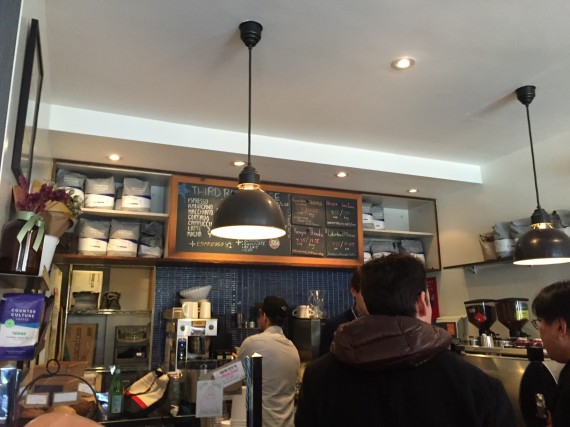
Inside Third Rail Coffee
A few weeks ago, I had the surprise pleasure of taking a coffee tour of the City. We visited a number of different kinds and types of coffeehouses — from corporate chains to European-style cafés — but one in particular stood out. It was called Third Rail Coffee. The menu was completely espresso-based, and there were no fluffy, Starbucks-style drinks at all: no Pumpkin Spice Whatevers or White Chocolate Somethings. “Pure” coffee. There was really no need for all the added sugar anyway, to be honest. The coffee was so good, so sweet, nothing needed to be added. I can easily say it was among the best — if not the best — espresso I’ve ever had.
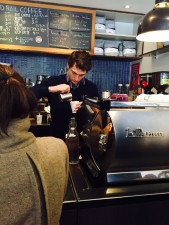
Barista-as-superhero.
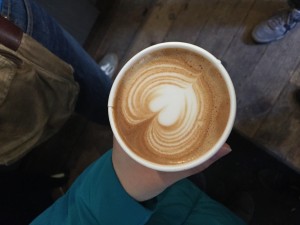
“Artisan” coffee at Third Rail Coffee, NYC.
This was luxury coffee to be sure: expensive, though cash-only, served in unusually small cups, with delicate artisan touches. But it’s interesting to note how little was made of the coffee itself: its origins, the workers who picked and brought it to market, the farmers who grew it. Starbucks makes much more out of these considerations than most independent shops, like Third Rail. The focus here was on the craft of brewing (or “pulling,” in the case of espresso) and serving it — what I call the “barista as superhero” model. Equally interesting was how many customers requested paper cups and how few drank from porcelain. One might expect high-end coffee like this to be served exclusively in high-end tasse à café. But it wasn’t. I attribute the broader dominance of cardboard cups both to Starbucks’ bad influence and to the tendency in NYC to always be rushed — but in this case, the lack of seating may be to blame.



